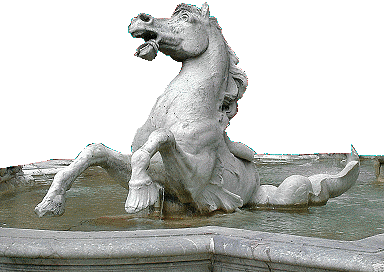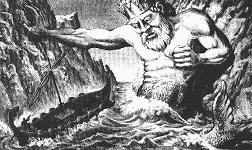POSEIDWN
(Poseidon)
God of the Sea and Lord of the Deep
 Roman Name: Neptune
Roman Name: NeptuneSacred Region: The Sea Totem Animals: Horses and Bulls How to Identify Him: Three-pronged trident
|
Images of Poseidon, courtesy of Laurel Bowman at the University of Victoria
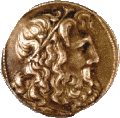 Although he is mostly known for ruling the waters, Poseidon
is the lord of the deep, meaning he is in
charge of earthquakes and other unpredictable movements of planet
Earth as well. Powell's section on him in Chapter 6 is short, but I think it's
wonderfully evocative when Powell describes him as "master of the terrifying movement
of the earth and the sea and the roaring thunder of horses' hooves beating over
the plain" (151). He's a violent, unforgiving god, rather like the fickle sea
he represents. This is not surprising; if you will look at the map of Greece on
the inside front cover of your text you can see how much of the country is made up
of coastline. The very pervasiveness of the sea made it inevitable that the Greeks
would be great sailors, but like all good sailors they knew that the sea is an
untrustworthy element.
Although he is mostly known for ruling the waters, Poseidon
is the lord of the deep, meaning he is in
charge of earthquakes and other unpredictable movements of planet
Earth as well. Powell's section on him in Chapter 6 is short, but I think it's
wonderfully evocative when Powell describes him as "master of the terrifying movement
of the earth and the sea and the roaring thunder of horses' hooves beating over
the plain" (151). He's a violent, unforgiving god, rather like the fickle sea
he represents. This is not surprising; if you will look at the map of Greece on
the inside front cover of your text you can see how much of the country is made up
of coastline. The very pervasiveness of the sea made it inevitable that the Greeks
would be great sailors, but like all good sailors they knew that the sea is an
untrustworthy element.
By the way, don't get "sea" mixed up with "ocean." There was an entirely separate body of water called "Oceanus," a deity in itself, that was supposed to surround the earth. According to the philosopher Thales in the seventh century B.C., the earth was a flat disk floating on Oceanus. No, this does not mean that the ancient Greeks all throught the earth was flat. Pythagoras proposed a round earth in the sixth century B.C., and Eratosthanes proved it three centuries later. So our own myth about Christopher Columbus is actually about 1700 years too late.
According to Homer, the three sons of Cronus and Rhea--Zeus, Hades, and Poseidon--drew lots to divide up the universe. Hades got the underworld, Zeus the sky, and Poseidon the sea and the waters, with all the minor gods and nymphs of the rivers and lakes under his sway. Olympus and the Earth were to be common ground, but Zeus would serve as the head king, rather as Agamemnon serves as the "king of kings" in Homer's Iliad. It must have been tough for Hades and Poseidon to accept their kid brother as their ruler, but of course without him they'd still be languishing in Cronus's stomach.
Poets love to describe Poseidon's beautiful palace under the sea, where he stables his famous white horses. These horses pull his golden chariot swiftly over the water and calm the sea as they pass, their manes visible as foam. When you think about it, the calming part of that particular story is rather ironic. It's got to be the only way in which Poseidon is associated with calm. You'd expect him to stir up storms everywhere he goes rather than the opposite.
Poseidon's wife is Amphitrite, daughter or granddaughter (depending on which account you're reading) of Oceanus. Amphitrite is a minor goddess who doesn't have a strong personality and who doesn't appear in mythology as anything other than Mrs. P. Perhaps Poseidon has got enough personality for both of them.
Like Zeus, Poseidon appears in many stories as a seducer, maybe because he seems to have started out as a fertility god. There are a number of stories of his fathering children with various nymphs, and he even made a pass at his own sister Demeter once. According to some sources he created the first horse in order to impress her when she asked him if he could invent the most beautiful animal ever seen. A more frequently told tale is the one of how Demeter ran across a lustful Poseidon when she was searching the earth for her missing daughter Persephone. In no mood for dalliance, she tried to hide in the form of a mare in a field. Imagine her chagrin when Poseidon responded by turning himself into a stallion. The result of their union was Arion, a talking horse who was sometimes described as having human forefeet.
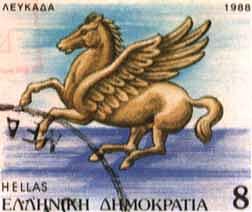 Poseidon also turned himself into a stallion to seduce the gorgon Medusa, who at that time had the
form of a beautiful woman. It was his fault that she wound up with her famous snakes for hair;
the place he chose for seduction was the temple of Athena, and the virgin goddess was furious
at such desecration of her sanctuary. She couldn't hurt her powerful uncle, but her revenge
on the object of his attentions was swift and thorough. When Perseus killed Medusa she was
pregnant with Poseidon's child, which is why Pegasus the winged horse sprang from her neck
when Perseus beheaded her. Athena seems to have had some regret for doling out such a harsh
punishment, as she took Pegasus to be cared for by the Muses in their home on Mount Helicon.
Their sacred inspirational spring, the Hippocrene ("hippos" means "horse" in Greek), is said
to have sprung up when Pegasus struck the ground with his hoof.
Poseidon also turned himself into a stallion to seduce the gorgon Medusa, who at that time had the
form of a beautiful woman. It was his fault that she wound up with her famous snakes for hair;
the place he chose for seduction was the temple of Athena, and the virgin goddess was furious
at such desecration of her sanctuary. She couldn't hurt her powerful uncle, but her revenge
on the object of his attentions was swift and thorough. When Perseus killed Medusa she was
pregnant with Poseidon's child, which is why Pegasus the winged horse sprang from her neck
when Perseus beheaded her. Athena seems to have had some regret for doling out such a harsh
punishment, as she took Pegasus to be cared for by the Muses in their home on Mount Helicon.
Their sacred inspirational spring, the Hippocrene ("hippos" means "horse" in Greek), is said
to have sprung up when Pegasus struck the ground with his hoof.
Because the horse is sacred to Poseidon, some archaeologists have wondered if the story of the wooden horse, which supposedly the Greeks used as a trick to get inside the gates of Troy after a ten-year siege, might actually have some grounding in fact. The site of Troy shows evidence of a powerful earthquake at just about the time that the Trojan War was supposed to take place, and of widespread destruction afterward. The theory is that quite possibly the earthquake that breached the walls was attributed to divine intervention on the part of Poseidon as an etiological myth, and then later the agent of destruction got transferred to Poseidon's attribute, the horse.
Personally I find the theory a little hard to swallow for one basic reason: Poseidon had helped to build those very walls that got knocked down. But it's kind of a neat idea anyway.
You might wonder how the god of the sea became a wall-builder. It all began when he got a little impatient with being bossed around by baby brother Zeus, and he started conspiring to become the head king. Zeus punished him with temporary banishment from Olympus and forced him to serve the Trojan king Laomedon, who ordered him to build the city walls. Luckily for Poseidon, Apollo was also in trouble with Zeus at the same time and had nothing better to do than to come down and help him with the task. Apollo was able to move stones with the power of his lyre, so the work was much easier with him around.
Unfortunately for King Laomedon, nobody ever told him who his wall-builders were. Not realizing that they were powerful gods, he tried to sneak out of paying a reward he had promised them. Always one to hold a grudge, Poseidon got so angry he took the Greek side in the Trojan War even though Laomedon was long dead. Apollo seems to have been more forgiving; he sided with the Trojans.
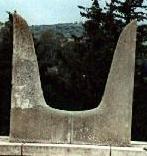 As we saw in the myths of Crete, especially the story of the bull from the sea, bulls are also scared to Poseidon. This association probably goes all the way back to Minoan days--the time
of the Linear B tablets that mention his name. A common element in frescoes and architecture
of the period were the "horns of consecration," a large example of which is pictured to the
left. We don't know much about the details of Minoan religious
belief, but we do know that bulls obviously had a place in it.
As we saw in the myths of Crete, especially the story of the bull from the sea, bulls are also scared to Poseidon. This association probably goes all the way back to Minoan days--the time
of the Linear B tablets that mention his name. A common element in frescoes and architecture
of the period were the "horns of consecration," a large example of which is pictured to the
left. We don't know much about the details of Minoan religious
belief, but we do know that bulls obviously had a place in it.
The combination of bulls and horses makes sense for a fertility god, as both animals were associated with strength and masculinity.
The best-known story about Poseidon is his quarrel with Odysseus in Homer's Odyssey. Odysseus blinds Poseidon's son, the cyclops Polyphemus, in one of the most famous episodes in the poem. The vengeful Poseidon pursues Odysseus relentlessly for ten years, keeping him from reaching home, and Odysseus might never have made it if it weren't for the fact that Poseidon went on vacation, heading off for a long banquet with the "blessed Ethiopians." Athena and Zeus take advantage of the sea god's absence and go into a huddle, plotting how to bring the hero home at last.
One of the most beautiful places in Greece is Poseidon's temple at Sounion, the furthest point on the mainland looking over the Aegean Sea. It was from this point that Aegeus is supposed to have dashed himself into the sea when he spotted the black sails on Theseus's ship returning from Crete--he had gone there so he could spot the ship at the earliest possible moment. In ancient times, boat races were held at Sounion in Poseidon's honor.
Poseidon is also associated with the Peloponnesus, which is named after the hero Pelops. Pelops had a dysfunctional childhood, to say the least. His father, Tantalus, cut him up and served him as dinner to the gods in a bizarre sort of test to see if they would figure out what was on the menu. They did, and they didn't appreciate his trick: he's now being punished in Tartarus, tortured with eternal thirst and hunger as he stands knee-deep in water that always retreats when he tries to drink, surrounded by trees heavy with fruit that's just out of his reach. This is where we get our word "tantalize."
The gods reconstructed Pelops after this experience...all except his shoulder. Poor Demeter had been worrying about Persephone again, and she had absent-mindedly gnawed Pelops's shoulder before she realized what she was eating. It had to be replaced with an ivory one.
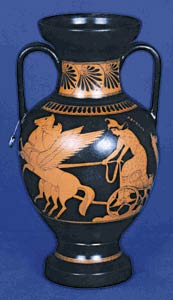 |
That's another dysfunctional family, by the way: Chrysippos (a male) was kidnapped and raped by Laius, the king of Thebes who was murdered by his own son Oedipus; Thyestes had an affair with Atreus's wife; and in revenge over the affair Atreus cooked up Thyestes' sons and fed them to him in a gruesome re-enactment of his father's childhood trauma.
And here you thought the Olympians were badly behaved!
In Greek art, Poseidon is depicted as a grown man almost indistinguishable from his brother Zeus. Only the attributes, like Poseidon's three-pronged trident or Zeus's thunderbolt, tell us the identity of the figure. One thing about his statues is sure--he is always stern and serious, being an angry and vindictive god in most of his stories.
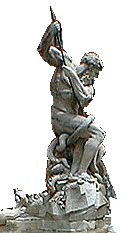 Later, Poseidon could be found on fountains around Rome as a
symbol of water and of the waves. He is usually surrounded by sea creatures
like dolphins and fish. Sometimes he's shown with a hippocampus, a horse with a
fish's tail.
Later, Poseidon could be found on fountains around Rome as a
symbol of water and of the waves. He is usually surrounded by sea creatures
like dolphins and fish. Sometimes he's shown with a hippocampus, a horse with a
fish's tail.
To read more about Poseidon, click here
and here
for entries from the Encyclopedia
Mythica and Perseus, click
here for an overview of myths about
Poseidon in
capsule form, and here for
ancient texts referring to him.